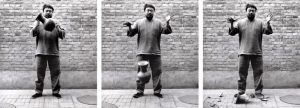What is it that differentiates a pot found underground from thousands of years ago from the ones on a pedestal in museums like the MET? What are the guidelines that consider one as an artifact of the past and one as a piece of art? Or can one object be both?
The textbook definition of an artifact is a “humanly made or modified portable object, such as stone tools, pottery, and metal weapons.” (Renfrew et al. 2018). This definition renders the aesthetic and skill level aspect of a found object to be irrelevant, making an artifact considered anything created by humans.
However, art is defined as “something that is created with imagination and skill and that is beautiful or that expresses important ideas or feelings” (Britannica Dictionary). Taking into account the beauty and expression of an object, many artifacts may fall out of place, but there is definitely overlap between the two. A simple stone vessel with no other intention than to store meat in the winter would likely have no beauty and communicate no ideas of the time, and thus is not art. However a carved stone such as the Venus of Willendorf is now considered one of the oldest surviving works of art.
The Venus of Willendorf, carved from limestone circa 24,000 BCE, is a 4.5 inch tall female figurine. She was named after the Roman goddess of love and beauty, although there is no relation or evidence that she represents that, because of her emphasized reproductive features and understated face and limbs (Zygmont 2015). Although her purpose is unknown, this figure is palm sized and would have been very easy to transport, just as other artifacts of the time. However, it is the aesthetic qualities and the unknown yet clearly existing intentions that went into making her that turn this piece of stone into an artwork that is now on display in the Naturhistorisches Museum of Vienna.
As a form of expression, artwork can offer much more information than just what people needed to live in prehistoric times, but also what they found to be important. From the Venus of Willendorf, we can see that this nomadic society had given an importance to women’s ability to reproduce, as the piece seems to reference fertility.
As art can be archaeology, archaeology can also be art. In 1995 Chinese artist Ai Weiwei created the photography series Dropping a Han Dynasty Urn, in which he drops a 2000 year old ceramic urn against the ground, shattering (Beres 2020). Giving this urn a new significance even in destruction, this piece emphasizes how important it is to remember and preserve the past.
Further Reading:
Paleolithic Art, An Introduction
The Case for Ai Weiwei
References:
“Art Definition & Meaning | Britannica Dictionary.” Accessed September 25, 2022. https://www.britannica.com/dictionary/art.
Beres, Tiffany Wai-Ying. “Ai Weiwei, Dropping a Han Dynasty Urn .” Smarthistory, August 25, 2020. https://smarthistory.org/ai-weiwei-dropping-a-han-dynasty-urn/.
Renfrew, Colin, and Paul Bahn. 2018. Archaeology Essentials: Theories, Methods, and Practice. Fourth edition. Thames & Hudson.
Zygmont, Bryant. “Venus of Willendorf .” Smarthistory, November 21, 2015. https://smarthistory.org/venus-of-willendorf/.



Think about how some artifacts are incorporated into art museums (especially ancient Egyptian, ancient Greek, and ancient Roman artifacts). Does the process of curating artifacts transform them into art in the modern day?
Whether the curating of an artifact defines the piece as artwork in the modern day depends mostly on the context. Seeing a Greek pot within the Met Museum versus within a Natural History Museum would change the qualities that are being analyzed and thus the importance of the piece.